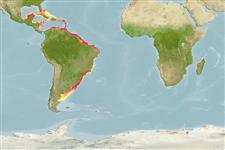Environment: milieu / climate zone / depth range / distribution range
Ökologie
seewasser; brackwasser demersal; tiefenbereich ? - 190 m (Ref. 47377), usually 18 - 70 m (Ref. 5217). Subtropical; 26°N - 53°S, 98°W - 34°W
Western Atlantic: Belize and Jamaica southward to Argentina Antilles, Central and South America (Ref. 26938).
Length at first maturity / Size / Gewicht / Alter
Maturity: Lm 26.2 range ? - ? cm
Max length : 45.0 cm TL Männchen/unbestimmt; (Ref. 104706); 45.0 cm TL (female); common length : 30.0 cm TL Männchen/unbestimmt; (Ref. 3822); max. veröff. Gewicht: 349.90 g (Ref. 131022)
Rückenflossenstacheln (insgesamt) : 9 - 10; Rückenflossenweichstrahlen (insgesamt) : 11 - 12; Afterflossenstacheln: 1; Afterflossenweichstrahlen: 10.
Found on sand or muddy bottoms of the continental and insular shelves. Occasionally occurs over reefs. Feeds on shrimps, crabs, other crustaceans and fishes. Traded as an aquarium fish at Ceará, Brazil (Ref. 49392).
Life cycle and mating behavior
Geschlechtsreife | Fortpflanzung | Ablaichen | Eier | Fecundity | Larven
Miller, G.C. and W.J. Richards, 1978. Triglidae. In W. Fischer (ed.) FAO species identification sheets for fishery purposes. West Atlantic (Fishing Area 31). FAO, Rome. Vol. 5. pag.var. (Ref. 3822)
IUCN Rote Liste Status (Ref. 130435: Version 2024-2)
Bedrohung für Menschen
Harmless
Nutzung durch Menschen
Fischereien: weniger kommerziell; Aquarium: Kommerziell
Tools
Zusatzinformationen
Download XML
Internet Quellen
Estimates based on models
Preferred temperature (Ref.
123201): 15 - 27.9, mean 26.1 °C (based on 464 cells).
Phylogenetic diversity index (Ref.
82804): PD
50 = 0.5000 [Uniqueness, from 0.5 = low to 2.0 = high].
Bayesian length-weight: a=0.00933 (0.00762 - 0.01143), b=3.00 (2.95 - 3.05), in cm total length, based on LWR estimates for this species (Ref.
93245).
Trophic level (Ref.
69278): 3.8 ±0.63 se; based on food items.
Generation time: 8.5 ( na - na) years. Estimated as median ln(3)/K based on 1
growth studies.
Widerstandsfähigkeit (Ref.
120179): niedrig, Verdopplung der Population dauert 4,5 - 14 Jahre. (K=0.13).
Fishing Vulnerability (Ref.
59153): High vulnerability (57 of 100).
Nutrients (Ref.
124155): Calcium = 68.1 [36.1, 163.5] mg/100g; Iron = 0.978 [0.538, 1.847] mg/100g; Protein = 17.4 [15.1, 20.4] %; Omega3 = 0.584 [0.275, 1.520] g/100g; Selenium = 30 [14, 70] μg/100g; VitaminA = 15.6 [6.0, 39.3] μg/100g; Zinc = 0.885 [0.634, 1.252] mg/100g (wet weight);
